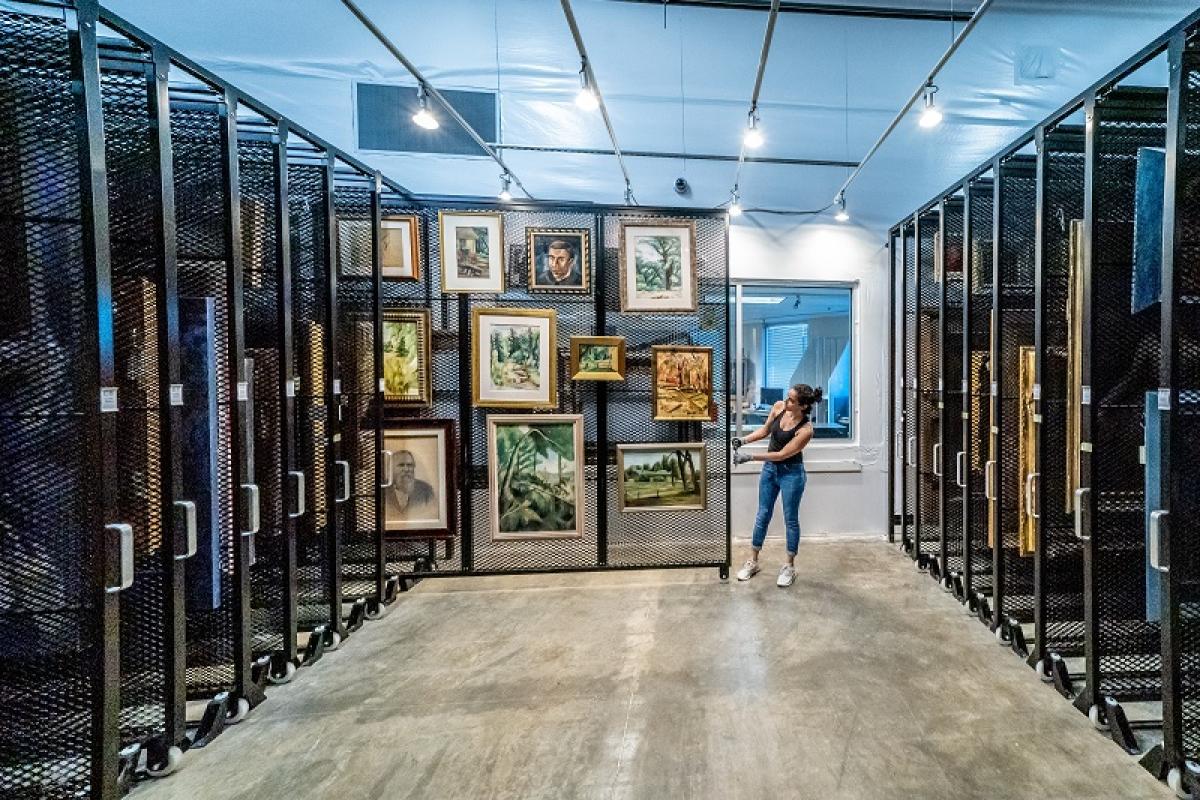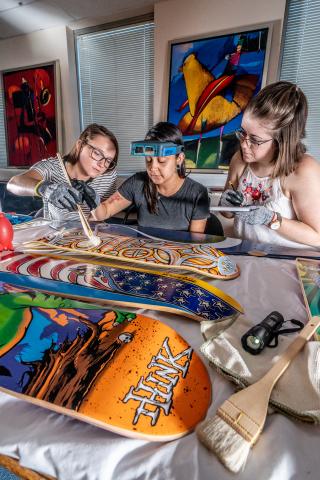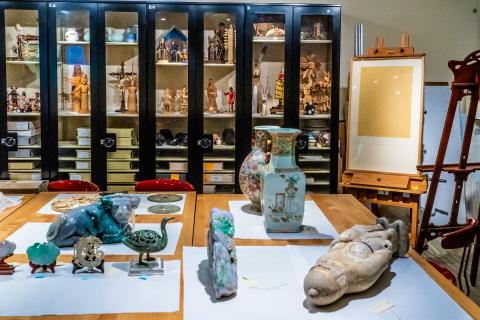Extensive Art Collection Housed at Off-Campus Facility

The first work of art Nessa Kerr ever held in her hands was a masterpiece: a landscape painting by the famed Albert Bierstadt, whose work hangs in the White House and galleries around the world.
But the painting, the inaugural 1891 donation to the University of Denver’s collection, lacked some of the luster it deserved. Radiator paint covered its frame, plaster filled its joints, a heavy backing weighed it down.
How things have changed.
Today, Kerr (MA ’15) is the collections manager at the Hampden Art Study Center (HASC), where she can roll out one of many wire-mesh panels and show anyone in the community a neatly preserved and cataloged Bierstadt (or Warhol or Gorin or Léger) in a shiny, re-gilded frame.
Things certainly have come a long way since 2014, when Kerr began working in the newly opened HASC, an offsite facility that stores the 4,000 items in DU’s care. Back then, Kerr says, “a lot of people didn’t even know we had a collection.” The curator of the University Art Collections and DU student collections assistants were merely trying to lasso the University’s holdings, which were scattered among an art storage facility, the Phipps Mansion and the basement of the Shwayder Art Building. It’s different now.
“You really get to see the breadth of what we have,” Kerr says, walking through a warehouse in the 4,000-square-foot, climate-controlled space. She gestures to the top shelf. “Our whole concept here is accessibility for students and for researchers. All of these pieces can be accessed with our library ladder. A staff member could go up and pull most of those pieces on the top shelf by themselves.”
Located near Hampden and Kipling in Lakewood, the HASC can do many of the things a museum can. A project space provides room for handling, framing and conservation — including a fumigation system that lets a conservator to work onsite if necessary. The loading dock out back allows for easy art transport between display spaces. With a photo studio, Kerr and her staff can catalog the collection digitally and post high-quality images online. A print and drawing study room hosts researchers and class trips, allowing visitors adequate space to examine objects.
“It’s a total game-changer,” Kerr says. “We basically now have the back half of a museum. The things that they can do behind the scenes, we can do that here. And before we had no way to even know what we had.”
Most obviously, the purpose of the HASC is holding and displaying the University’s diverse collection, which ranges from paintings to photography to sculpture to rugs to 159 uniquely painted skateboards. But since its opening, the HASC also has become a sought-after experiential learning opportunity for DU graduate students.
In addition to DU staff members, a staff of students keeps things running smoothly. As many as 10 prospective art historians, collections managers, archivists, librarians and collections managers are on the payroll at any given time. While Kerr handles the more difficult collections projects and training, the students do a lot of the remaining legwork: processing, cataloging, transporting, installing and taking inventory of the pieces, in addition to facilitating class visits and tours (which anyone can schedule).
The experience students gain has paid dividends, Kerr says. HASC alumni have secured jobs at the History Colorado Center, the Denver Art Museum and, in the case of Renee Bedard (MLIS ’19), the Community College of Aurora (CCA).
“When I got into the [Master of Library and Information Science] program, people told me I should take a job or two to supplement what I was learning about and get experience in the field,” says Bedard, a collections assistant who graduated in June. “But I almost feel like school is supplementing this experience.”
Classes made more sense, Bedard says, because she already had a taste of their content while working at HASC. And she could apply what she learned through the practical projects she took on at the facility.
Her time at the HASC provides the perfect preparation, Bedard says, for her new job as CCA’s student success librarian. She chalks up the opportunity to the experience she received at the place she describes as a “hidden gem” of DU.
“It’s low key and down to earth,” she explains. “It doesn’t feel like one of those archives where you’re not allowed in it.”
Kerr and her team want more people to know about HASC. She’s encouraging the campus community to schedule a visit and interact with the collection.
“It’s different than when you walk into a museum and the art is on the wall,” she says. “You can’t really get personal with the art. This is a great way … to deal with the object [and] see it up close. Anyone who has any interest in art, this is worth their time.”










